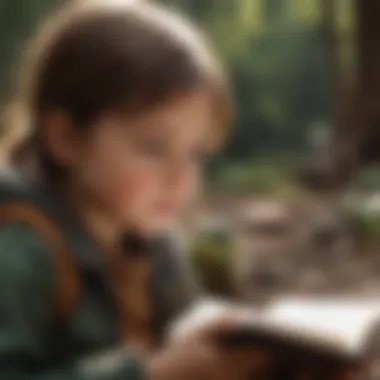Online Books for Eight-Year-Olds: A Detailed Guide


Nature Topic Overview
In today’s digitally connected world, children find themselves surrounded by a vast sea of information that can sometimes be overwhelming. This article takes a closer look at online books specifically designed for eight-year-olds, focusing on narratives that spark their interest in nature and the environment. At this stage, children are incredibly curious, constantly asking questions about the natural world and their place within it. Therefore, selecting the right literature is crucial not just for entertainment but also for education.
The importance of literature that encourages exploration is paramount. Online resources provide easy access to a variety of genres that can truly enhance an eight-year-old’s understanding of topics such as ecosystems, species diversity, and environmental stewardship. Equipping young readers with knowledge means offering them the tools to engage with the world around them, fostering a love for learning that lasts a lifetime.
Fun Facts and Trivia
Imagine your kid excitedly waving their hands after learning that a honeybee can flap its wings over 200 times a second! It’s these little nuggets of knowledge that often make reading captivating. Here are some fun facts that could be found in various online books:
- Did you know? The blue whale, the largest animal on Earth, can weigh as much as 33 elephants.
- Quirky tidbit: A group of flamingos is known as a "flamboyance."
Fun visuals and interactive elements often accompany these facts, bringing learning to life. Think about online books that include games or interactive slideshows that illustrate concepts like habitats or food chains, allowing children to grasp ideas more effectively.
Wildlife Explorations
When kids dive into wildlife exploration-themed books, they embark on a journey into different environments. Whether it’s the dense Amazon rainforest or the frozen tundras of the Arctic, each habitat houses incredible creatures. For instance:
- Rainforest: Home to jaguars and countless species of birds, the rainforest is bustling with biodiversity.
- Arctic: Polar bears and seals are just some of the unique animals adapted to this chilly climate.
Online resources really shine by offering quizzes or puzzles about these animals. For example, after reading a chapter about penguins, a child might engage with a short quiz, reinforcing what they've learned while keeping them entertained.
Environmental Awareness
Stressing the importance of conservation, online books often introduce young readers to the concept of sustainability. For eight-year-olds, learning how they can contribute to preserving nature is empowering. It isn’t just about reading; it’s about action as well. The following might be suggestions they find:
- Reduce plastic usage: Teach kids to use reusable bags or bottles.
- Plant trees: Engaging in tree-planting activities can be a delightful and educational experience.
"An environmentally aware child is the future of our planet. By starting young, we can cultivate a generation that values the environment."
DIY Nature Activities
Books that invite hands-on experience can make a world of difference. Encouraging kids to engage in DIY nature activities allows for practical application of their knowledge. Here are some potential projects:
- Nature Journal: Have kids pick a plant or animal to observe and sketch in a notebook.
- Homemade Bird Feeder: Using recyclable materials, this project teaches resourcefulness while attracting local wildlife.
A step-by-step guide on how to create something nature-inspired can enhance their creative skills and understanding of the environment. Kids might also venture outside for treasure hunts or nature walks, helping them see learning in action.
By focusing on these engaging elements, parents and educators can effectively guide youngsters toward discovering the wonders of nature, embedding a lifelong love for reading and learning.
The Importance of Reading at Eight
At the age of eight, children are often on the cusp of significant cognitive and emotional development. Reading becomes not just a pastime but a building block for their growth. It’s during this period that kids start to form connections between letters and sounds. The books they choose can lay the groundwork for lifelong learning.
Developmental Milestones
By eight, children are typically advancing in their literacy skills and their encounters with books serve as a critical milestone. They transition from simply recognizing words to actually understanding the narratives and concepts presented in stories. This comprehension doesn’t just happen by chance; it requires engaging literature that resonates with their experiences and curiosity. Interactive narratives allow them to actively participate in the storytelling.
In fact, reading at this age influences their emotional intelligence as well. Books that feature relatable characters or situations can help them process their own emotions and develop empathy. When a young reader sees a character overcome a challenge, they can reflect on their own life experiences, creating an essential link between literature and reality.
Some key milestones that highlight the importance of this age include:
- Increased Vocabulary: An expanded vocabulary opens doors to self-expression.
- Understanding Themes: Children get better at grasping larger concepts, such as friendship, bravery, and loss.
- Diverse Interests: They begin to explore various genres, sparking interests that might translate into lifelong passions.
Reading can thus be seen as more than a skill; it's a source of discovery that shapes their world in a positive way.
Cognitive Benefits of Reading
Now let’s talk about the brain. Reading stimulates cognitive functions, enhancing children's ability to think critically and solve problems. At eight, their capacity for imagination and abstract thinking is blossoming. Selecting the right online books can therefore serve as an essential tool for nurturing these skills. Books that introduce complex ideas in a digestible manner can empower them to explore deeper questions about themselves and the world around them.
Reading also hones concentration and focus. Many young children might struggle with short attention spans. Engaging stories can absorb their minds, leading to improved attention skills. Furthermore, when children recount a story or discuss a character's actions, they engage in analytical thinking that promotes cognitive development.
Some cognitive benefits of reading at this age include:
- Enhanced Memory: Remembering characters, plots, and lessons sharpens their recall abilities.
- Critical Thinking: Analyzing a story helps kids learn how to evaluate situations and make decisions.
- Improved Language Skills: They learn grammar and sentence structure through repetition in reading, enhancing their communication skills.
"Reading is to the mind what exercise is to the body." – Joseph Addison
In summary, the importance of reading at eight cannot be overstated. It caters to various developmental milestones while providing numerous cognitive benefits that prepare children for future academic challenges. Parents, educators, and carers should strive to present a variety of reading options that align with the interests and capabilities of children at this critical stage.


Defining Online Books
In today’s digital age, defining online books is crucial to understanding how children engage with literature. The concept broadens the scope of reading beyond traditional print, fostering an interactive experience that can significantly enhance learning. Online books cater to the curiosities of young minds, especially for eight-year-olds who are voraciously exploring the world around them.
Digital Formats Explained
Digital books come in various formats, each designed to suit different reading preferences and technological accessibility. Children may encounter eBooks, which are typically downloadable files that can be read on devices like tablets or computers. These can range from simple text-based stories to richly illustrated adventures. Then there are interactive eBooks, which often incorporate animations, music, and even quizzes that hold the attention of younger readers. Each format serves as a tool for engaging children, making learning both fun and dynamic.
To better understand this, consider some common formats:
- PDFs: Often used for academic resources, these maintain the layout of a printed page but lack interactivity.
- EPUB: A flexible format for eBooks that adjusts to different screen sizes and allows for more interactive features.
- Audiobooks: Perfect for auditory learners, these capture the story in a text-free format, allowing children to listen while they visualize.
Choosing the right format can significantly affect a child’s reading experience and comprehension.
Benefits of Online Literacy
Understanding the benefits of online literacy is vital for parents and educators alike. Access to a wide variety of literature through online platforms can help spark a child's interest in reading. Here are some key points:
- Variety of Choices: Children can easily explore genres that capture their attention, be it adventure tales or educational nature books.
- Accessibility: Online books are available at all times, allowing families to extend reading beyond library hours.
- Engagement: Many online books include features that make reading an active experience. Children can tap to get definitions of difficult words or watch videos related to the story.
"The world of online books opens infinite doors for discovery, making reading a captivating journey for children!"
In summary, defining online books involves understanding their formats and the significant advantages they provide. This leads to greater engagement and a more robust learning experience for young readers, particularly those exploring the intricacies of nature and far-off worlds.
Genres That Resonate with Eight-Year-Olds
When it comes to choosing books for eight-year-olds, the genres selected play a pivotal role in honing their interest and sustaining their attention. At this age, children are transitioning into more structured forms of reading, where they can enjoy both narratives and educational content. The stories they engage with can shape their understanding of the world. Accessing diverse genres allows them to explore varied thoughts, personalities, and situations, enriching their cognitive and emotional intelligence.
Adventure and Exploration
Adventure tales are especially popular amongst young readers. This genre opens the floodgates to imagination, allowing children to dive into worlds far removed from their daily lives. Think of books like The Wild Robot by Peter Brown, where themes of survival and friendship are intricately woven into a narrative that keeps the pages flipping.
These stories often encourage children to think critically about problems and solutions, fostering an adventurous spirit. Exploring themes like bravery, teamwork, and ethics within these adventures can spark discussions around real-life challenges children might face. Engaging with adventure books not only builds reading skills but also instills the understanding that exploration, whether of the world or one’s own abilities, is essential.
Fiction vs. Non-Fiction
Understanding the difference between fiction and non-fiction literature can shape how children perceive and interact with the world around them. Fictional works like Charlotte's Web by E.B. White offer a lens into emotional narratives, providing characters that kids can relate to or learn from. On the other hand, non-fiction books, such as National Geographic Kids: Weird But True! deliver facts and real stories about our planet.
Both forms have their place, and ideally, a balance should be struck in a child’s reading selection. Fiction strengthens empathy and creative thinking, while non-fiction nurtures a child’s factual understanding of the world, encouraging them to ask questions about everything from historical events to scientific concepts. Allowing children to navigate both realms helps them become well-rounded individuals.
Books Focused on Nature
Books that focus on nature, such as The Lorax by Dr. Seuss, are vital for young readers. They not only entertain but also educate about the environment, encouraging a love for the planet. Through engaging stories, children learn about ecosystems, biodiversity, and the importance of conservation.
By connecting narrative elements to real-world issues, children develop a sense of responsibility towards nature. They learn the implications of actions — both good and bad — on the environment. Such stories inspire curiosity, making them eager to explore outdoors and interact with their surroundings, whether it’s identifying trees in their backyard or noticing the habitats of local wildlife.
"Books can serve as a window to the world; through them, children see possibilities, understand environments, and feel connected to green spaces and the great outdoors."
Engaging with various genres ultimately creates a richer reading experience for eight-year-olds, addressing a range of interests while building lifelong skills.
Recommendations for Nature-Themed Online Books
In a world increasingly dominated by screens and digital consumption, the importance of connecting young readers with nature through literature cannot be overstated. Nature-themed online books offer an engaging way for eight-year-olds to explore the wonders of the natural world right from their homes. These books foster curiosity and instill a sense of environmental stewardship, which is particularly crucial as children are coming of age in a time where ecological awareness is more relevant than ever.
By choosing nature-themed online books, parents and educators create opportunities for kids to learn about ecosystems, wildlife, and the environment in a captivating manner. Such literature often combines storytelling with educational content, making it easier for children to grasp complex topics related to the earth, biology, and conservation. Additionally, these books can serve as a bridge to outdoor activities, allowing students to apply what they read and see the world around them with a newfound perspective.
Interactive eBooks
Interactive eBooks enhance the reading experience for young minds by actively engaging them. This format often allows children to participate in the story, making choices that can lead to different outcomes, or enabling them to tap on images to learn more about a topic. For instance, an interactive eBook about forests might offer clickable diagrams of different tree species, complete with sounds of the forest, imagery, and even mini-quizzes to test their knowledge.
Incorporating multimedia elements like animations, videos, and sound effects makes learning immersive. It captivates the child’s attention, keeping them glued to the material while helping to reinforce learning through interaction. Such books often address various literacy skills as well, aiding in vocabulary development and comprehension, which are foundational during these formative years. Parents should consider platforms like Epic! and TumbleBooks, which host numerous interactive eBooks tailored for this age group.
Educational Platforms Offering Books
There is a plethora of educational platforms that offer an extensive selection of nature-themed books targeted at eight-year-olds. Websites like Raz-Kids and Scholastic Book Clubs provide curated lists that emphasize nature, science, and the environment. These platforms do not just offer a collection of titles; they often come equipped with additional resources such as lesson plans, discussion questions, and activities that parents can use to enrich their children’s reading experience.
Moreover, many educational platforms allow for personalized reading lists that can align with a child's personal interests or current school projects. This customization encourages children to delve into subjects they are naturally drawn to, enriching their overall knowledge base.
"Books hold the power to transport children to worlds beyond their imaginations, and nature-themed literature might just ignite the curiosity that leads to lifelong learning about our planet."


Incorporating such resources into a child's reading routine not only keeps them engaged but also strengthens their understanding of their surroundings, paving the way for them to develop their own unique perspective on the environment. Through strategic selection, families can shape a reading environment that nurtures a child’s love for nature, complemented by adequate educational resources.
Educational Value of Specific Titles
Choosing the right books for eight-year-olds isn't just about entertaining stories or colorful illustrations; it's about imparting valuable lessons and knowledge that stick with children as they develop. The educational impact of certain titles can sow the seeds of curiosity and inspire a lifelong love for learning. All children are unique and their engagement with books will vary, but comprehensive discussions about content quality and integration into their learning can make all the difference.
Assessing Content Quality
When we talk about the content quality of children's literature, it's crucial to look beyond the cover. Good books for this age group should captivate, educate, and challenge them intellectually. Here are a few factors to consider:
- Relevance: Does the book address topics meaningful to children? For instance, a story about the environment that features animals they might see in their backyard fosters connection and empathy.
- Accuracy: With a plethora of information available, it’s imperative that the content is factually sound. Books that include factual elements like species names or descriptions can vastly enhance a child’s learning experience.
- Age Appropriateness: The language and themes should match their maturity. Simplistic language may frustrate advanced readers, while overly complex themes might confuse young minds. Look for books that strike a balance.
One great example is the series of books like "The Magic School Bus" which combine adventure with scientific facts, thus engaging children in learning without them even realizing it. Their excitement comes from the characters' escapades, but they walk away with nuggets of knowledge about science and nature that can last a lifetime.
"Books are a uniquely portable magic." — Stephen King
Integrating Books into Learning Curricula
Books, especially those focusing on nature, can serve as fantastic supplements to formal education. Integrating literature into learning can transform a standard curriculum into an engaging experience. Here’s how you can do this:
- Thematic Units: Align literature with what the child is learning at school. If the child studies ecosystems, selecting books that discuss habitats or the lifecycle of different animals can reinforce their understanding.
- Discussion-Based Learning: Encourage conversations around the stories they read. Asking questions about characters' decisions can help children develop critical thinking skills.
- Creative Projects: After reading, inspire children to create projects based on the book. This could be drawing animals from the story or even starting a small garden project after reading about plant growth.
Incorporating these strategies can elevate comprehension and retention, making reading less of a chore and more of an inviting challenge. Books are not just for leisure; they form a bridge to broader knowledge and understanding, a passport to the natural world that fuels their imagination.
Engaging with knowledgeable texts is vital; it has the power to turn mere ideas into rich concepts that children can relate to, building not only their vocabulary but also their worldview.
Making Reading Accessible
Making reading accessible is crucial for fostering a love of literature, especially for eight-year-olds who are just starting to develop their reading habits. At this age, children are curious, eager to explore, and receptive to learning through diverse materials. Online books play an instrumental role in this process by breaking down barriers that traditional print media may impose. We delve into how various platforms can offer not just convenience, but also a treasure trove of knowledge and creativity tailored for young minds.
Platform Comparisons
When looking at platforms for eBooks, it's beneficial to compare what each offers. Some popular platforms like Amazon Kindle, Epic!, and OverDrive each have their own strengths that cater to different needs:
- Amazon Kindle: Known for its extensive library, the Kindle offers a wide range of titles, including many popular series that children love. The user-friendly interface makes it easy for young readers to navigate.
- Epic!: This platform specifically targets younger readers by providing a vast selection of books, audiobooks, and even educational videos. It has a subscription model, which means families can access numerous titles without needing to buy each one individually.
- OverDrive: Often accessible through local libraries, OverDrive allows children to borrow eBooks just like physical books. It encourages library use and introduces kids to the treasure trove of literature available within their community.
Each platform represents different facets of accessibility. From independent purchasing to library borrowing, parents can choose one that aligns best with their family’s reading goals and budget.
Cost Considerations for Families
Cost is an undeniable factor when it comes to reading resources. Not all families have the same financial flexibility, and making digital books accessible can be a challenge. However, various options can accommodate different budgets:
- Free Resources: Websites like Project Gutenberg offer free access to classic literature. These can be a fantastic starting place.
- Library Memberships: Many local libraries have embraced the digital age, allowing children to check out eBooks and audiobooks for free.
- Subscription Services: Platforms like Epic! often provide free trials, so families can explore the offerings without an immediate investment.
- Purchasing Titles: For books that families feel passionate about or want to own, think about keeping an eye out for promotions or sales on sites such as Barnes & Noble or through Kindle offers.
Balancing cost with access ensures that children can engage with literature despite financial constraints, supporting the belief that reading should be a right, not a privilege.
"The more children read, the more they explore, and the bigger their world becomes. Access to literature should never be limited by budget or resources."
In summary, making reading accessible is about choice—not just the choice of what to read, but also how and where to get those books. By comparing platforms and considering costs carefully, families can make informed decisions that support their children’s love for reading.
Fostering a Reading Environment at Home
Creating an inviting and stimulating reading space at home is crucial for nurturing young minds. When children are encouraged to read in a relaxed and engaging environment, it fosters a love for books and enhances their overall learning experience. This section addresses the significant elements of establishing a reading-friendly home, emphasizing key benefits and considerations.
Establishing Routine Reading Habits
Routine reading habits are essential for children, especially at the age of eight. Establishing a daily reading schedule can create a sense of security and predictability in a child's life. By integrating reading into their daily routine, kids learn to value this activity and eventually perceive it as a pleasurable part of their day. Here are some ideas to cultivate these habits:
- Set a Specific Time: Designate a particular time each day for reading. It could be before bed or right after school. Consistency is key.
- Use a Timer: Encourage children to read for a set amount of time, say 15 to 30 minutes. As they become more engrossed, they may naturally extend this duration.
- Make it a Family Affair: Set an example by reading alongside them. When parents engage in their reading, it sends a powerful message about the value of books.
Incorporating short discussions about the stories they've read can enhance comprehension. Children can share their favorite parts or characters, stimulating critical thinking and communication skills.
Creating a Cozy Reading Nook
A cozy reading nook transforms reading from a mundane task into an inviting escape. It's important to create a space that feels safe, comfortable, and tailored to your child's preferences. Here are some tips:
- Choose the Right Spot: Find a quiet corner in your home where distractions are minimal. Natural light can enhance the atmosphere, making it appealing to spend time there.
- Comfortable Seating: Invest in soft cushions, bean bags, or a small armchair. Physical comfort significantly impacts how much time kids spend in their nook.
- Decorate: Allow the child to personalize their nook with their favorite colors, characters, or themes. Bright, engaging decorations can draw them in.
- Keep Books Accessible: Have a small bookshelf or basket filled with a variety of age-appropriate titles. Having books within reach can inspire spontaneous reading sessions.
"Creating a nurturing space for reading significantly enhances children's engagement, encouraging lifelong reading habits."


By establishing a reading nook, you foster a welcoming environment that encourages those little feet to wander towards books instead of screens.
By effectively fostering a reading environment at home through daily routines and dedicated spaces, parents can instill a love for literature in their children that could last a lifetime.
Engaging with Nature Beyond the Books
Engaging with nature is not merely a concept but a pivotal element in the development of young minds, especially for eight-year-olds. Although online books can provide foundational knowledge, the real magic happens when this knowledge is applied outside the confines of a digital screen. Connecting reading to real-world experiences enhances learning in a profound way, making it not only memorable but also applicable to a child’s everyday life.
When kids step into the great outdoors after diving into an educational book, they embark on a journey where the inked words transform into tangible experiences. Nature walks, field trips, and outdoor activities breathe life into the stories they read, nurturing their curiosity while forming meaningful connections with the environment. Here, we explore two key components that bolster engagement with nature beyond online literature.
Field Trips and Nature Walks
Field trips and nature walks stand out as avenues that fuel a child's understanding of the environment. The potential these activities hold is immense—they allow children to immerse themselves directly in the subject matter they have been reading about.
- The Learning Experience: Experiencing a forest, a beach, or a local park offers a sensory experience that a book cannot replicate. Seeing the vibrant colors of flowers or feeling the rough bark of a tree engages children’s senses in a way that fosters deeper understanding.
- Physical Engagement: These adventures encourage movement and exercise, which is essential for physical development. They confront children with real-life scenarios that nurture problem-solving skills and teamwork when navigating trails or sites together.
- Bonding Time: Traveling together as a family or group can solidify relationships. Shared experiences help in building memories that last a lifetime.
Moreover, many educational institutions offer field trips geared specifically toward nature education. Programs that include guided explorations can enhance the insights gained from reading, whereby students are paired with knowledgeable guides who share fascinating details about local wildlife and ecosystems.
"Experiencing nature firsthand allows children to relate to the material they learn in books, transforming information into understanding."
Combining Online Reading with Outdoor Activities
The idea of blending online reading with outdoor activities serves as an effective strategy for reinforcing knowledge while keeping the fun alive. Here are some practical thoughts on how to bring this combination to life:
- Themed Scavenger Hunts: After completing a book about animals, families can organize scavenger hunts in their gardens or local parks. Kids can look for specific plants or animals mentioned in their stories, bringing excitement to learning.
- Book Character Roleplays: Encourage children to act out stories they read while outdoors. Pretending to be their favorite character amidst nature can inspire creativity and spontaneity.
- Nature Journals: Following a reading session, children can create nature journals documenting their observations from outdoor explorations. Drawing sketches or jotting down thoughts about the flora and fauna not only builds creativity but also deepens their connection with what they've read.
These strategies not only make outdoor activities enjoyable but also allow concepts learned through online books to take root in the child's mind. By merging literature with real-world interaction, children are more likely to retain information while developing a lifelong love of both reading and nature.
Parental Guidance in Book Selection
Selecting the right books for children is no small feat. As parents, we play a crucial role in guiding our young readers towards literature that not only captivates their attention but also aids in their overall development. In a world teeming with choices, parental guidance in book selection serves as a compass, steering children towards the right paths in their literary journey.
One of the primary benefits of parental involvement is understanding individual interests. Every child is a unique bundle of curiosity. It’s paramount to tune into what sparks their imagination. If your child is enthralled by animals, diving into nature-themed stories might awaken their passion for wildlife. In contrast, if they’re fascinated by minerals or historical tales, books focused on adventures that incorporate these elements could be quite impactful. Parents can start by simply asking what stories they've enjoyed in the past or what subjects pique their interest. From there, exploration becomes much easier and tailored.
Understanding Individual Interests
To pick the right books, it helps to have a finger on the pulse of your child’s interests. This means engaging in conversations about their hobbies, favorite movies, or things they notice outside while playing. Questions like "What was the last book you enjoyed?" or "What do you like to do outside?" can provide invaluable insight.
- Create an Interest List: Parents can jot down topics their child shows excitement about. This could be anything from dinosaurs, planets, or underwater worlds. Keep this list handy while searching for new books.
- Explore Various Formats: Online platforms often categorize books by themes, making it easier to find titles that resonate with your child's curiosities. If a child shows interest in ocean life, look for interactive eBooks that allow exploration of underwater ecosystems.
The more we engage with our children regarding what intrigues them, the easier it becomes to select engaging literature. Choices based on genuine interest can make reading a cherished activity rather than just a chore.
Evaluating Age Appropriateness
Once you have a handle on what your child enjoys, the next step is ensuring the books are age-appropriate. Understanding what aligns with their maturity level is key to fostering a healthy reading habit. Books should challenge them just enough without being overwhelming or confusing.
- Consider Content Complexity: Younger children often benefit from books with clear narratives and straightforward vocabulary. As children grow and their comprehension skills develop, introducing more complex plots or elaborate themes becomes beneficial.
- Assess Emotional Themes: Some stories touch on sensitive subjects, like loss or friendship challenges. Parents should review the themes within the books to make sure they align with the child's emotional maturity and experience.
Guiding children to the right books isn't about shielding them but rather about equipping them with the tools they need to fully engage with varied narratives.
Navigating this world of literature is like exploring an intricately crafted maze. With parenting as a guiding light, children can wander through the pages with curiosity and confidence, crafting their own reading identities along the way.
The Future of Digital Reading for Children
The pace at which the digital landscape is evolving cannot be overstated. For children, especially those around the age of eight, the way they access and interact with literature is undergoing a remarkable transformation. As more families turn to digital mediums for reading material, understanding the implications of this shift becomes crucial for educators and parents alike.
Now, it’s not just about reading text off a screen—digital reading incorporates a variety of elements like audio, animations, and interactive features. This evolution is not trivial; it reshapes how young minds comprehend stories and grasp information. Children are not simply passive consumers of text; they engage with dynamic content that piques their interest and keeps them coming back for more.
One of the many benefits of embracing online books is accessibility. With a few clicks, a child can access a universe of stories that might otherwise be tucked away on shelves. This kind of exposure can lead to richer vocabulary and broader knowledge, especially concerning topics like nature and science, which are often deeply embedded within children's literature.
"Digital reading not only opens up a world of imagination but also puts educational resources right at children’s fingertips, inspiring them to explore further."
Emerging Technologies Impacting Reading
The horizon of children’s literature is being dramatically altered by advancements in technology. Innovations such as augmented reality (AR) have begun to find their way into ebooks, allowing children to interact with characters and environments in ways that traditional books simply can't match. For example, a child reading about a rainforest can view 3D trees or listen to the sounds of wildlife, making the experience immersive.
Another exciting aspect is the development of apps and platforms that personalize reading experiences. Algorithms analyze children’s reading levels and preferences, recommending tailored literature that grips their attention. This customization can have profound effects on a child’s enthusiasm towards reading, giving them a sense of ownership over their learning journey.
Furthermore, the rise of digital libraries enables children to explore vast collections that might be otherwise financially out of reach. Parents can discover myriad free or low-cost resources, easing the strain on household budgets while still fostering a love of reading.
The Role of Artificial Intelligence in Literature Access
Artificial intelligence is poised to play a monumental role in literature accessibility. With smart search tools, AI can simplify finding titles best suited for a child's reading level and interest. This means less time being frustrated in search of an appropriate book and more time engaged in meaningful reading.
Moreover, AI-driven platforms can help monitor a child’s reading habits, providing crucial feedback to parents and educators. For instance, if a child is particularly drawn to adventure stories, tailored recommendations can further deepen their engagement with reading, creating pathways to more complex literature as their skills develop over time.
The future of reading for children stands on the precipice of vibrant change, wherein technology and literature intertwine seamlessly to create enriching experiences. These evolving digital landscapes not only support children's curiosity but also nurture their educational growth, potentially reshaping generations of young readers.







